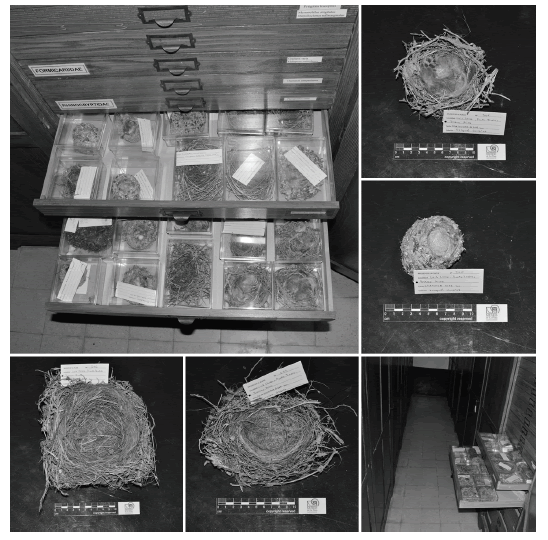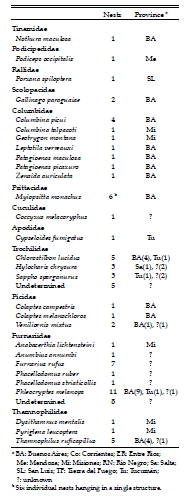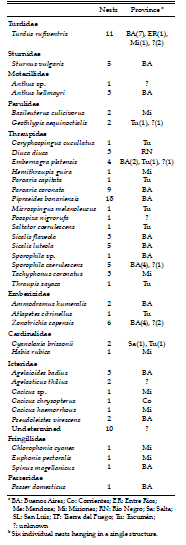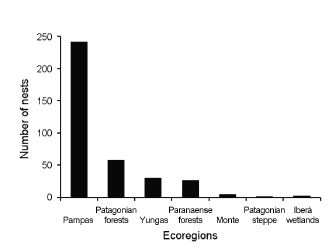Services on Demand
Journal
Article
Indicators
-
 Cited by SciELO
Cited by SciELO
Related links
-
 Similars in
SciELO
Similars in
SciELO  uBio
uBio
Share
El hornero
Print version ISSN 0073-3407On-line version ISSN 1850-4884
Hornero vol.33 no.1 Ciudad Autónoma de Buenos Aires Aug. 2018
ARTÍCULO
Avian nest collection of Argentina: an unexplored resource for research
Facundo Quintela 1,2, Exequiel González 1 and Luciano N. Segura 1
1 Sección Ornitología, Museo de La Plata, Universidad Nacional de La Plata. Paseo del Bosque s/n, B1904CCA La Plata, Buenos Aires, Argentina.
ABSTRACT
Studies based on avian nest collections had several advantages for researchers, such us to establish direct comparisons avoiding locating the nests in the field or the preservation over time of the nest material. Nonetheless, access to nest collections usually becomes an issue for researchers, due to the lack of information of their contents. This study present the contents of the La Plata Museum nest collection in order to encourage a greater use of this valuable resource. The collection holds 435 nests built by 101 species in 30 families. Some nests stand out due to the lack of knowledge about the breeding biology of the species, like the Black-capped Piprites (Piprites pileata), the Plumbeous Black-Tyrant (Knipolegus cabanisi), the Dot-winged Crake (Porzana spiloptera), the Greenish Schiffornis (Schiffornis virescens) and the Bay-ringed Tyrannulet (Phylloscartes sylviolus). In the collection are well represented the species of Pampas ecoregion (242 nests), as well as Patagonian forests (58 nests), Yungas (30 nests) and Paranaense forests (27 nests).
KEY WORDS: Bird collection; La Plata Museum; Ornithology; Pampas ecoregion.
RESUMEN
Colección de nidos de aves de Argentina: una fuente inexplorada de investigación.
Los estudios basados en colecciones de nidos de aves tienen varias ventajas para los investigadores; por ejemplo, establecer comparaciones directas evitando tener que ubicar los nidos en el campo o preservar en el tiempo el material del nido. No obstante, el acceso a las colecciones de nidos suele ser un problema para los investigadores, debido a la falta de información de sus contenidos. En este trabajo se presentan los contenidos de la colección de nidos de aves del Museo de La Plata, con el objetivo de incentivar un mayor uso de este valioso recurso. La colección cuenta con 435 nidos correspondientes a 101 especies de 30 familias. Se destacan nidos de especies con muy poca información de su biología reproductiva como el Bailarín Castaño (Piprites pileata), la Viudita Plomiza (Knipolegus cabanisi), el Burrito Negruzco (Porzana spiloptera), el Flautín (Schiffornis virescens) y la Mosqueta Cara Canela (Phylloscartes sylviolus). En la colección están bien representadas las especies de la ecorregión Pampeana (242 nidos), así como también el Bosque Patagónico (58 nidos), las Yungas (30 nidos) y la Selva Paranaense (27 nidos).
PALABRAS CLAVE: Colección de aves; Ecorregión Pampeana; Museo de La Plata; Ornitología.
Received 27 October 2017
Accepted 28 August 2018
Museum collections, especially nest collections, are usually an untapped research resource (Suarez and Tsutsui 2004, Russell et al. 2013). Although it is unclear the reason for the underuse of nest collections around the world, it could be due to their poor maintenance, fragmentation, missing data on nest tags, inaccessibility, and mainly a lack of awareness in the research community (Russell et al. 2013). Argentinian nest collections are scarce and the data is not easily available for researchers. An exception is the Santa Fe Natural Science “Florentino Ameghino” Museum that holds 146 nests catalogued with detailed data (Leiva et al. 2004).
The ornithological collection of the La Plata Museum belongs to the National University of La Plata, whose first specimens were catalogued in 1893. This collection holds more than 24000 pieces: 15000 skins, 4000 skeletons, 600 mounted models (Olmedo et al. 2016), 3800 eggs (Segura et al. 2014a, 2014b, Scheffer et al. 2015), 350 tissue samples (Montalti et al. 2015) and also nests. Although this collection holds nests from different world regions, it particularly represents the birds of the Southern Cone of South America and specially the Pampas ecoregion. The objective of this contribution is to present the contents of the La Plata Museum nest collection to make it more available for the scientific community.
METHODS
We carefully compared the catalogued nests in the original book with the actual pieces to detect data inconsistencies and missing or destroyed nests. Missing or completely destroyed nests were deregistered, while for the partially destroyed ones the nest material was conserved. Original tags provided information as species, date and site of collection, collector’s name, tree species were the nest was built or occurrence of brood parasitism, among others. We remade all tags following standardized protocols in Argentinian museums, although original tags were always kept. All data was also digitalized in a standardized database.
We added new nests to the collection that mainly came from recent studies from breeding birds in natural forests of central-east Argentina, while other nests were donated by other researchers and naturalists. Small and medium sized nests were stored in acrylic boxes (Fig. 1), and larger nests were sealed in zip lock plastic bags.

Figure 1. Images of the La Plata Museum nest collection, Argentina. Above left and down right, individual acrylic boxes with nests; above right, a nest of Yellow-browed Tyrant (Satrapa icterophrys); middle right, a nest of Masked Gnatcatcher (Polioptila dumicola); down left, a nest of Rufous-bellied Thrush (Turdus rufiventris); and down middle, a nest of Red-crested Cardinal (Paroaria coronata).
RESULTS AND DISCUSSION
The La Plata Museum nest collection holds 435 nests built by 101 species in 30 families (Table 1). Most of the nests were determined to the species level, 0.9% (4 nests) to the genus level and 4.4% (19 nests) to the family level. Nest collected in Buenos Aires Province represented 66.2% (243 nests) of the total collection (Table 1). Pampas was the best represented Argentinian ecoregion (66.3%, 242 nests), but also the Patagonian forests (15.9%, 58 nests), Yungas (8.2%, 30 nests), and Paranaense forests (7.4%, 27 nests) (Fig. 2). The collection is mainly composed of Argentinian native species. An exception is the European Starling (Sturnus vulgaris), originally from Eurasia and introduced in Argentina about three decades ago and currently expanding its distribution (Navas et al. 2002). Studies of nest material and nest-cavity architecture could be valuable for its control (Ibañez 2015).
Table 1. Species represented in the La Plata Museum nest collection, Argentina, with indication of number of nests and province where each nest was collected.




Figure 2. Number of nests by Argentinian ecoregion (Brown and Pacheco 2006) of the La Plata Museum nest collection, Argentina.
For the Pampas ecoregion stands out the nests of the Barn Swallow (Hirundo rustica), a species that breed exclusively in North America, but in the 1980 decade a small breeding population was found in coastal Argentina (Martinez 1983). Since then, the breeding range of the Barn Swallows has greatly expanded (Segura 2017). In this ecoregion also highlights four species of passerines that breed regularly in natural forest of central-east Argentina (locally known as Talares) of which were collected a large number of nests for scientific research: the Vermilion Flycatcher (Pyrocephalus rubinus), the Masked Gnatcatcher (Polioptila dumicola), the Small-billed Elaenia (Elaenia parvirostris), and the Blue-andyellow Tanager (Pipraeidea bonariensis). In addition, for the Patagonian forests ecoregion have also been recently incorporated 58 nests from breeding biology studies of the Chilean Swallow (Tachycineta leucopyga).
For the Yungas ecoregion stands out the nests of the Slaty Elaenia (Elaenia strepera) and the Plumbeous Black-Tyrant (Knipolegus cabanisi), two species with nests poorly known and with scarce or null information about their breeding biology (de la Peña et al. 1996). For the Monte ecoregion there are nests of the Common Diuca-Finch (Diuca diuca), an interesting species due to its hybridization with the critically endangered Yellow Cardinal (Gubernatrix cristata), and also a nest of the Dotwinged Crake (Porzana spiloptera), a species with a poorly known reproductive biology (López-Lanús et al. 2012).
Finally, for the Paranaense forest stands out the nest of the Black-capped Piprites (Piprites pileata), a species with local endangered populations that were resighted in Argentina after 47 years (Maders et al. 2007), a nest of the Greenish Schiffornis (Schiffornis virescens), whose genus has been mostly studied for the Northern Hemisphere (Skutch 1969, Snow 2004; but see Bodrati and Cockle 2017), and nests of the White-shouldered Fire-eye (Pyriglena leucoptera), the Rufous Gnateater (Conopophaga lineata) and the Bay-ringed Tyrannulet (Phylloscartes sylviolus), species with scarce information about their breeding biology (Protomastro et al. 2002, Kirwan et al. 2010, de la Peña 2016).
Compared to the nest collection of the Santa Fe Natural Science Museum (Leiva et al. 2004), the La Plata Museum nest collection contains more than double of nests, with more than 430 nests. Other museums in Argentina with ornithological collections also have nests, such as the Museo Argentino de Ciencias Naturales “Bernardino Rivadavia” (Buenos Aires), the Museo de Ciencias Naturales “Miguel Lillo” (Tucumán), and the Museo de Ciencias Naturales “José Lorca” (Mendoza). Notwithstanding, most of them are part of the hall exhibitions and do not constitute the ornithological collection.
Nest collections can provide a lot of research possibilities in diverse ornithological topics, like materials used, building methods, temporal and geographic differences (intra and interspecific), organic debris from parents and chicks, and presence of ectoparasites (see also Russell et al. 2013). These data make nest collections highly valuable and long lasting sources of information which in many cases can exceed ornithology. Due to nests are part of the avian phenotype and respond to genetic patterns regarding the behaviour of their construction, they can also provide evidence of phylogenetic and taxonomic relationships (Collias 1986). In this sense, some authors have used the nest structural characteristics (in addition to the egg structural characteristics) for taxonomic studies (Prum 1993, Whitney et al. 1996, Giannini and Bertelli 2004, Bertelli and Giannini 2005). We consider of paramount importance that all scientific institutions owning a nest collection, commit to develop it and make the data available, in order to encourage further studies in ornithology.
ACKNOWLEDGEMENTS
We are grateful to technical staff and interns of the La Plata Museum ornithological collection (Eduardo Etcheverry and Luis Pagano) for their collaboration. We also thank Gabriela Vargas (Museo de Ciencias Naturales “José Lorca”), Benjamin Bender (Instituto Argentino de Investigaciones de las Zonas Áridas), Sebastián Aveldaño (Museo de Ciencias Naturales “Miguel Lillo”) and Dario Lijtmaer (Museo Argentino de Ciencias Naturales “Bernardino Rivadavia”) for the valuable information provided. We are grateful to Diego Montalti and Hugo López for allowing us to conduct this study in the La Plata Museum ornithological collection. The last author is a CONICET Research Fellow.
LITERATURE CITED
1. BERTELLI S AND GIANNINI NP (2005) A phylogeny of extant penguins (Aves: Sphenisciformes) combining morphology and mitochondrial sequences. Cladistics 21:209-239 [ Links ]
2. BODRATI A AND COCKLE KL (2017) Nest, eggs and reproductive behavior of Greenish Schifforns (Schiffornis virescens). Brazilian Journal of Ornithology 25:273-276 [ Links ]
3. BROWN A AND PACHECO S (2006) Propuesta de actualización del mapa ecorregional de la Argentina. Pp. 28-31 in: BROWN A, MARTINEZ ORTIZ U, ACERBI M AND CORCUERA J (eds) La situación ambiental argentina. Fundación Vida Silvestre Argentina, Buenos Aires [ Links ]
4. COLLIAS N (1986) Engineering aspects of nest building in birds. Endeavour 10:9-16 [ Links ]
5. GIANNINI NP AND BERTELLI S (2004) A phylogeny of extant penguins based on integumentary and breeding characters. Auk 121:422-234 [ Links ]
6. IBAÑEZ LM (2015) Invasión del Estornino Pinto Sturnus vulgaris en el noreste de la provincia de Buenos Aires: análisis de la competencia con aves nativas y potencialidad como transmisor de parásitos. Doctoral thesis, Universidad Nacional de La Plata, La Plata [ Links ]
7. KIRWAN GM, BODRATI A AND COCKLE K (2010) The nest of the Bay-ringed Tyrannulet (Phylloscartes sylviolus), a little-known Atlantic forest endemic, supports a close relationship between Phylloscartes and Pogonotriccus. Ornitología Neotropical 21:397-408 [ Links ]
8. LEIVA LA, VERÓN SN AND ACOSTA MD (2004) Nidos de aves pertenecientes a la colección del Museo Provincial de Ciencias Naturales “Florentino Ameghino”, Santa Fe, Argentina. Comunicaciones del Museo Provincial de Ciencias Naturales “Florentino Ameghino” 18:1-69
9. LÓPEZ-LANÚS B, GÜLLER R, VEIGA JO, AMORÓS P, MELO O, GARCÍA J, RAGONESI M, BODRATI G AND GÜLLER P (2012) Descripción del pichón del Burrito Negruzo (Porzana spiloptera). Hornero 27:195-198 [ Links ]
10. MADERS C, FARIÑA N AND BODRATI B (2007) Redescubrimiento del bailarín castaño (Piprites pileata) en Argentina. Ornitología Neotropical 18:127-131 [ Links ]
11. MARTÍNEZ MM (1983) Nidificación de Hirundo rustica erythrogaster (Boddaert) en la Argentina (Aves, Hirundinidae). Neotrópica 29:83-86 [ Links ]
12. MONTALTI D (2015) La colección ornitológica del Museo de la Plata. Revista Museo 27:51-58 [ Links ]
13. NAVAS JR (2002) Las aves exóticas introducidas y naturalizadas en la Argentina. Revista del Museo Argentino de Ciencias Naturales 4:191-202 [ Links ]
14. OLMEDO MASAT OM, SCHEFFER M, ARCHUBY D AND MONTALTI D (2016) La colección oológica de aves no passeriformes del Museo de La Plata. Revista del Museo de La Plata 1:109-116 [ Links ]
15. DE LA PEÑA MR (1996) Descripción de nidos nuevos o poco conocidos de la avifauna argentina. Hornero 14:85-86 [ Links ]
16. DE LA PEÑA MR (2016) Aves argentinas: descripción, comportamiento, reproducción y distribución. Trogonidae a Furnariidae. Comunicaciones del Museo Provincial de Ciencias Naturales “Florentino Ameghino” 20:1-620
17. PROTOMASTRO JJ (2002) Notes on the nesting of Whiteshouldered Fire-eye Pyriglena leucoptera. Cotinga 17:73-75 [ Links ]
18. PRUM RO (1993) Phylogeny, biogeography, and evolution of the broadbills (Eurylamidae) and asities (Philepittidae) based on morphology. Auk 110:304-324 [ Links ]
19. RUSSELL DG, HANSELL M AND REILLY M (2013) Bird nests in museum collections: a rich resource for research. Avian Biology Research 6:178-182 [ Links ]
20. SCHEFFER M, OLMEDO MASAT OM, SEGURA LN AND MONTALTI D (2015) La colección de huevos del Museo de La Plata: especies de Eurasia, Oceanía, África y Norteamérica. ProBiota, Serie Técnica y Didáctica 30:1-26 [ Links ]
21. SEGURA LN (2017) Southward breeding range expansion of the Barn Swallow (Hirundo rustica) in Argentina. Cotinga 39:60-62 [ Links ]
22. SEGURA LN, BOGADO N, DARRIEU CA AND MONTALTI D (2014a) La colección de huevos “Pablo Girard” del Museo de La Plata. ProBiota, Serie Técnica y Didáctica 27:1-15
23. SEGURA LN, BOGADO N, DARRIEU CA AND MONTALTI D (2014b) La colección de huevos “Ronald Runnacles” del Museo de La Plata: historia y material depositado. Revista del Museo de La Plata, Sección Zoología 24(182):1-9
24. SKUTCH AF (1969) Life histories of central American birds. III. Families Cotingidae, Pipridae, Formicariidae, Furnariidae, Dendrocolaptidae and Picidae. Pacific Coast Avifauna 35:1-580 [ Links ]
25. SNOW DW (2004) Family Pipridae (manakins). Pp. 110-169 in: DEL HOYO J, ELLIOTT A AND CHRISTIE DA (eds) Handbook of the birds of the world. Volume 9. Cotingas to pipits and wagtails. Lynx Edicions, Barcelona [ Links ]
26. SUAREZ AV AND TSUTSUI ND (2004) The value of museum collections for research and society. BioScience 54:66-74 [ Links ]
27. WHITNEY BM, PACHECO JF, DA FONSECA PSM AND BARTH RH (1996) The nest and nesting ecology of Acrobatornis fonsecai (Furnariidae) with implications for intrafamilial relationships. Wilson Bulletin 108:434-448 [ Links ]














